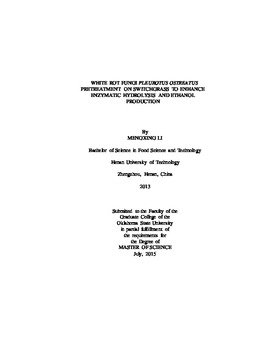| dc.contributor.advisor | Wilkins, Mark R. | |
| dc.contributor.author | Li, Mengxing | |
| dc.date.accessioned | 2016-04-15T21:49:28Z | |
| dc.date.available | 2016-04-15T21:49:28Z | |
| dc.date.issued | 2015-07-01 | |
| dc.identifier.uri | https://hdl.handle.net/11244/33430 | |
| dc.description.abstract | Biofuels and high value chemicals derived from cellulosic biomass are good substitutes for petroleum energy and are more environmentally beneficial than corn or soybean based biofuels. The high cost of biomass conversion to biofuels is the main impediment for large scale biofuel production, in which pretreatment is one of the most expensive processing steps. White rot fungal pretreatment shows good potential to efficiently degrade lignin and enhance enzymatic hydrolysis and fermentation under mild environmental conditions. In this thesis biological pretreatment was applied to switchgrass with an emphasis on white rot fungi-associated pretreatment. Two specific studies were conducted: Pleurotus ostreatus pretreatment on large switchgrass bales (either square or round bales) in a natural environment and lab scale P. ostreatus pretreatment in a controlled environment. For the study in a natural environment, P. ostreatus was applied to large switchgrass bales and stored for 9 months. Sampling was done at three months, five months, seven months and nine months after fungus applied. Fungal treated samples were subjected to composition analysis, hydrothermolysis pretreatment and enzymatic hydrolysis. Fungal treated square bales had a lignin fraction ranging from 1.8% to 3.2% higher than untreated bales. There were no clear trends for composition of hydrothermolysis pretreated samples or glucose yield from enzymatic hydrolysis. Fungus did not grow in round bales and bale moisture contents varied between 6% and 11%, which was too low for fungal growth. Glucan and lignin contents of stored samples increased and xylan contents decreased from March to May and were constant from May to September. For enzymatic hydrolysis of hydrothermolysis (200 �C/10 min or 180 �C/20 min) treated samples, there were no significant differences among samples of unwashed and washed samples, which indicates washing is not necessary. For the lab study in a controlled environment, switchgrass was treated with varied initial inoculum loading and substrate moisture content. Results showed that no ethanol was produced during SSF of untreated switchgrass. For fungal treated samples, after 80 days fungal pretreatment, samples with 75% substrate moisture content and 5 ml initial inoculum loading had the highest lignin degradation, 52%, and the highest ethanol yield, 45%. | |
| dc.format | application/pdf | |
| dc.language | en_US | |
| dc.publisher | Oklahoma State University | |
| dc.rights | Copyright is held by the author who has granted the Oklahoma State University Library the non-exclusive right to share this material in its institutional repository. Contact Digital Library Services at lib-dls@okstate.edu or 405-744-9161 for the permission policy on the use, reproduction or distribution of this material. | |
| dc.title | White Rot Fungi Pleurotus Ostreatus Pretreatment on Switchgrass to Enhance Enzymatic Hydrolysis and Ethanol Production | |
| dc.type | text | |
| dc.contributor.committeeMember | Buser, Michael | |
| dc.contributor.committeeMember | Atiyeh, Hasan | |
| dc.contributor.committeeMember | Marek, Stephen | |
| osu.filename | Li_okstate_0664M_14108.pdf | |
| osu.accesstype | Open Access | |
| dc.description.department | Biosystems & Agricultural Engineering | |
| dc.type.genre | Thesis | |
